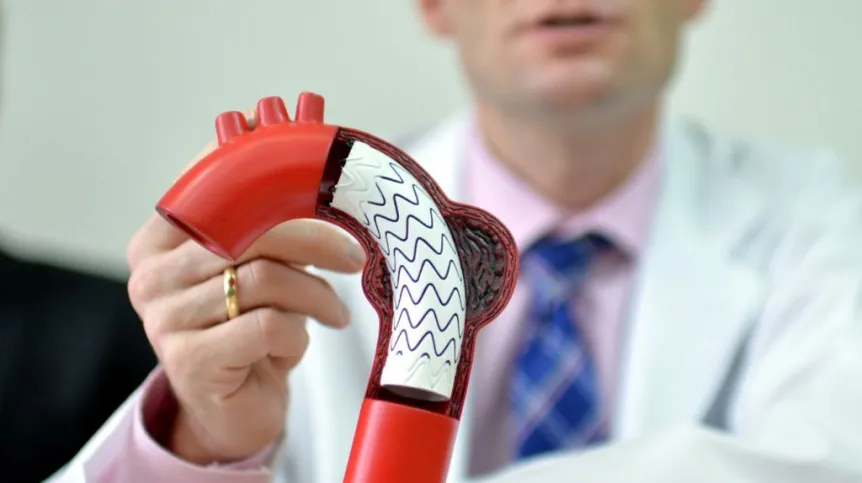
Poland\'s first two treatments of aneurysm in the aortic arch using minimally invasive method were conducted on last week on Monday and Tuesday by specialists from the Medical University of Warsaw.
"We operated on two patients aged 80 and 85 years, in whom traditional open chest surgery with cardiopulmonary bypass would be more risky" - said at a meeting with journalists Head of the Department of General, Vascular and Transplant Surgery, Prof. Sławomir Nazarewski.
Rector of the Medical University of Warsaw Prof. Miroslaw Wielgoś emphasised that the Medical University\'s clinic is the first in the country and world\'s tenth centre that used this innovative method for the treatment of aortic aneurysms. "This is the latest technology used in vascular surgery" - he added.
The procedure was performed by Assoc. Tomasz Jakimowicz in collaboration with Prof. Sławomir Nazarewski, aided by Dr. Robert Tworus and Dr. Katarzyna Grygiel. Medical supervisor was Prof. Tilo Koelbel of vascular medicine clinic of the University Heart Center in Hamburg, he did not, however, participate in the surgery.
The minimally invasive method involves the introduction of so-called stent graft (artificial vessel) into the aorta in the place of the aneurysm, or excessive widening of the vessel. "It is inserted with a catheter into the interior of the vessel in a coiled form, and then expanded to the interior walls of the aorta" - Assoc. Tomasz Jakimowicz explained to PAP journalist.
With the introduction of stent graft, aneurysm is not exposed to bleeding and rupture, which is a direct threat to life. Prof. Nazarewski said that in one of the patients, who underwent the procedure, aneurysm reached 8 cm, but usually its diameter does not exceed 3.5 cm.
Treatments of aneurysm in the aortic arch (located in the mediastinum, between the ascending and descending aorta) are particularly demanding. "The main difficulty is setting the stent graft precisely in the right place, because three vessels connect to the convex arch of the aorta: brachiocephalic artery, the left common carotid artery and the left subclavian artery. It must be therefore located so that the sleeves protruding from the stent graft are precisely in the location of these vessels" - explained Assoc. Jakimowicz.
Prof. Nazarewski said that vascular prostheses for both patients had to be done on special order, because in each person the aortic arch with vascular branches is slightly different. Precise adjustment would not be possible otherwise.
The same difficulties exist in the case of introduction of stent graft with branches (sleeves) in other aneurysms, e.g. renal or thoraco-abdominal aneurysm. Therefore, as of now they are performed only in a few, most experienced centres dealing with the treatment of endovascular aortic aneurysms.
Department of General, Vascular and Transplant Surgery of the Medical University of Warsaw specializes in minimally invasive surgery since 1998. Endovascular treatment of aortic aneurysms has been performed in more than 2 thousand patients, and about 200 stent graft implantations per year are performed.
Prof. Wielgoś said that the clinic has a huge tradition of implementation of new technologies from the beginning of its activity. Years ago it was headed by Prof. Jan Nielubowicz, who 50 years ago, in January 1966, pioneered kidney transplants in our country. Since then, the centre has performed more than 2.5 thousand kidney transplants and 120 simultaneous pancreas and kidney transplants.
Prof. Tadeusz Tołłoczko, which was head of the Department of General, Vascular and Transplant Surgery for many years, recalled that in the past, in his time, aortic aneurysm surgery was among the most difficult and dangerous procedures. "Mortality of patients was high, there were no stent grafts. Progress in medicine means that today more and more treatments are minimally invasive" - he said in an interview with PAP journalist during the press conference.
Assoc. Jakimowicz is convinced that minimally invasive surgery will dominate the treatment of all aortic aneurysms. "Even now in many western countries aneurysm of the ascending and abdominal aorta are treated this way. More and more often this procedure is used to treat aneurysms in the aortic arch and peri-renal aortic aneurysms" - said the specialist.
In Poland, due to the high cost of treatment, traditional surgery still dominates in the treatment of aortic aneurysms. Minimally invasive method is used only in patients in whom conventional surgery would be too risky.
PAP - Science and Scholarship in Poland, Zbigniew Wojtasiński
zbw/ zan/ mrt/
tr. RL













